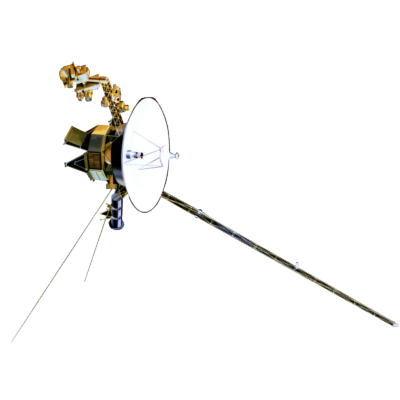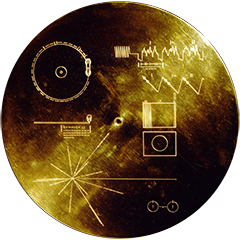Voyager LECP Data Analysis Handbook
Data File Descriptions
Experiment Data Record (EDR) Format Specification
Cruise 5
(From Document 618-306, Revision D)
The LECP EDR science physical record corresponds to a 9.6 minute measurement period. Any data not present within a given physical record is filled with zeroes.
A major LECP measurement cycle is 24 minutes. Hence, there are 5 physical records or 2 LECP major cycles per 48 minute period.
The physical science record structure is shown in Figure 8.3-1.
Figure 8.3-1. LECP Physical Science Tape Records
|
Standard Header (60 Words) |
Subheader (8 Words) |
Data Block (480 Words) |
60 MF 96 Min 548 Words |
All Words 32 bits.
One physical record contains a standard EDR Header followed by a science subheader followed by a science data block. One physical record contains all the data from 60 telemetry frames relevant to the experiment. Total record length is 548 words (60 MF; 9.6 min).
Figure 8.3-4 and Table 8.3-1 define the structure and contents of the LECP science record subheader.
Figure 8.3-4. LECP Science Subheader Format (CR-5)
|
EDR |
Bits 31 15 0 |
31 0 | ||
| 1 | LECP CMD MF 2 |
LECP CMD |
LECP CMD MF 42 |
Spare |
| 3 | Spare | Spare | ||
| 5 | Spare | Spare | ||
| 7 | Spare | Spare | ||
Total block length is 8 EDR (32-bit) words (60 MF; 3 CMD Words).
MF shown are MF out of 60 MF.
Command Word Format:
| 15 0 | ||||||||||||||||
Table 8.3-1. LECP EDR Science Subheader Block Table (CR-5)
| Item | Word | Bits |
Description |
| 1 | 1 | 31-16 | LECP Command Word MF19 |
| 2 | 1 | 15-0 | LECP Command Word MF22 |
| 3 | 2 | 31-16 | LECP Command Word MF42 |
| 4 | 2 | 15-0 | Spare |
| 5 | 3 | 31-0 | Spare |
| 6 | 4 | 31-0 | Spare |
| 7 | 5 | 31-0 | Spare |
| 8 | 6 | 31-0 | Spare |
| 9 | 7 | 31-0 | Spare |
| 10 | 8 | 31-0 | Spare |
Figure 8.3-5 and Table 8.3-2 define the structure and contents of the LECP science logical records.
Figure 8.3-5. LECP EDR Science Logical Record Format (CR-5)
| MF | EDR Word |
Bits |
|||
| 31 | 15 0 | 31 | 15 0 | ||
| 1 | 1 | P1* | P1 | P1 | P1 |
| 3 | R1 | R1 | R1 | R1 | |
| 5 | P2 | P2 | P2 | P2 | |
| 7 | P3 | P3 | P3 | P3 | |
| 2 | 9 | R2 | R2 | R2 | R2 |
| 11 | P4 | P4 | P4 | P4 | |
| 13 | P5 | P5 | P5 | P5 | |
| 15 | R3 | R3 | R3 | R3 | |
| 3 | 17 | P6 | P6 | P6 | P6 |
| 19 | P7 | P7 | P7 | P7 | |
| 21 | R4 | R4 | R4 | R4 | |
| 23 | P8 | P8 | P8 | P8 | |
The above structure repeats 20 times for a total of 960 PHA/Rate Words.
Both P and R 40-bit blocks are treated as four 10-bit data words.
This logical record length is 24 EDR (32-bit) words (3 MF; 48 PHA/Rate words). A physical record consists of 20 logical records (60 MF; 9.6 min; 480 EDR Words).
P = PHA; R = Rate
Logical records are packed into the science data blocks of physical records according to Figure 8.3-1. The standard EDR header is defined for CR-5 in Appendix C.
A segment number (1-5) is assigned to each of the five physical records that constitute two LECP instrument cycles. Each numbered segment then always contains the same number and type of data words (both the subheader and the science data block).
Summary
The telemetry and EDR parameters for each experiment are summarized in Figure 8.10-1. The telemetry parameters include:
A. Experiment bit fields
B. Data word bit lengths
B. Data words per MF
The EDR parameters for subheader and Data Block include:
A. Minor frames
B. Time period
C. Experiment Data Words
D. EDR (32-Bit Words
Next: Cruise 6
Return to EDR main page.
Return to Data File Descriptions main page.
Return to Voyager
LECP Data Analysis Handbook Table of Contents.
Return to Fundamental
Technologies Home Page.
Updated 8/9/19, Cameron Crane
VOYAGER 1 ELAPSED TIME
*Since official launch
September 5, 1977, 12:56:00:00 UTC
VOYAGER 2 ELAPSED TIME
*Since official launch
August 20, 1977, 14:29:00:00 UTC
QUICK FACTS
Mission Duration: 40+ years have elapsed for both Voyager 1 and Voyager 2 (both are ongoing).
Destination: Their original destinations were Saturn and Jupiter. Their current destination is interstellar space.



